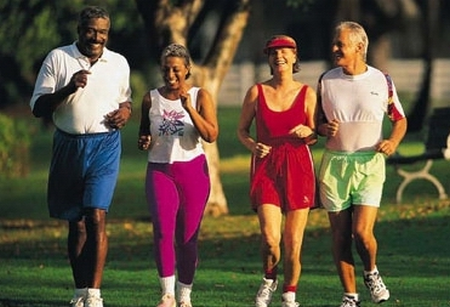Osteoporosis is a silent chronic disease that produces a loss of bone mass resulting in structural deterioration of the skeleton and increased susceptibility to bone breakage, this disease is mostly seen in senior citizens and many require stair lifts to move around their house without pain and difficulty. This is why building and maintaining bone density is a lifetime pursuit. The bones reach peak density between the ages of 20 and 30, but 90 percent of adult bone mineral content is deposited by the end of adolescence. This is a time when youngsters of both sexes should be getting enough calcium (approximately 1,200 to 1,500 mg/day), vitamin D (400 lU/day), and consistent exercise of a weight-bearing aerobic type plus weight training.
The most common fracture sites associated with osteoporosis are vertebral crush fractures (bones of the spinal column) and fractures of the hip, wrist, and femur (thigh bone). The death rate within the first year after a hip fracture in an elderly person is 18 percent to 33 percent, and most of those who survive have a diminished quality of life.
Risk Factors for Osteoporosis
Some factors that increase the likelihood of developing osteoporosis are:
1. Age
2. Gender. Women are more susceptible than men, particularly those with a small, thin skeletal framework and those who experience early menopause. Men also develop osteoporosis, but they lose bone more slowly and usually incur bone fractures when they are older.
3. Heredity. The risk is greater when other family members have osteoporosis.
4. Lack of physical activity. Physical activity stresses the bones and maintains the integrity of the skeletal system.
5. Cigarette smoking: Smoking suppresses estrogen production in females, leading to early menopause and loss of the skeletal protection provided by estrogen.
6. Insufficient intake of calcium and vitamin D. It is probably effective and prudent to suggest that all adults consume 1,200 to 1,500 mg of calcium from food and supplements each day. Vitamin D is needed for the body to absorb calcium. Adults up to 60 years of age should take in 400 1U (International Unit) of vitamin D daily; adults ages 60 to 69 should increase to 600 IU daily; and those ages 70 and older should take in 800 IU daily.
Although osteoporosis is treatable, it is not curable. The best approach is to prevent or delay its advent. The most important preventive technique is to develop as much bone as possible during the teenage years.
Effects of Exercise
Bone is living tissue that responds to the downward force of gravity and the lateral forces generated by the forceful contraction of muscles. Weight-bearing, impact-loading exercises such as walking, jogging, aerobic dancing, and stair-climbing can increase bone mass. Even the skeletal systems of nursing-home residents (average age 87 years) have responded to exercise with an increase in bone mass. Non-weight-bearing activities such as swimming and stationary cycling are not as effective in increasing bone density.
Researchers have examined the effect of resistance weight training on the skeletal system. Studies have indicated that bones respond to weight training by becoming thicker and denser. For good results, weight-training exercises should be done at an intensity level equal to 80 percent of 1 repetition maximum (1RM). This is approximately equivalent to performing 10 lifts, or repetitions, of an exercise with a weight heavy enough so it cannot be lifted 11 times. Exercises that stress the major muscle groups should be selected so the bones to which they are attached also will be stressed.
